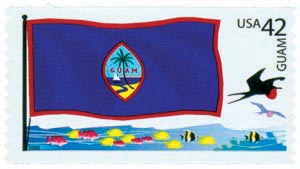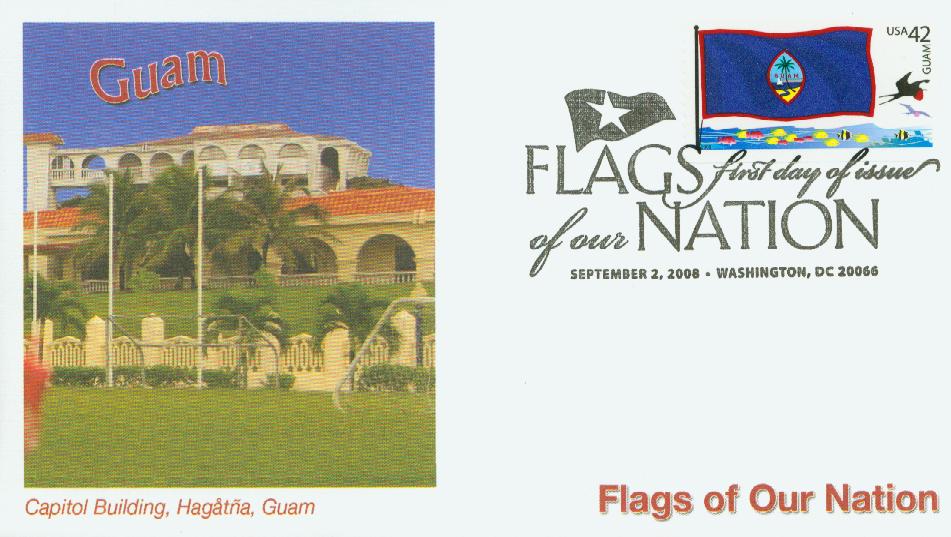
# 4286 - 2008 42c Flags of Our Nation: Guam
Â
Flags of Our Nation
Guam
City: Washington, DC
Battle Of GuamÂ
The largest of the Mariana Islands, Guam had been a United States possession since its capture from Spain in 1898. However, following the attack on Pearl Harbor, Japanese forces took the island on December 10, 1941.

In June 1944, the Allies launched Operation Forager to capture the Mariana Islands and Palau in the Pacific. They chose Saipan, Tinian, and Guam because of their size and ability to serve as supporting bases for the next phase of operations against the Philippines, Taiwan, and the Ryukyu Islands.
The invasion of Saipan came first, on June 15. The plan was to then invade Guam on June 18; however, there was a much larger Japanese force on Saipan than expected, so the battle for Guam had to be delayed for over a month.
While the battle for Saipan continued, American naval and air forces bombarded Guam. A week before the invasion, underwater demolition teams came in and removed beach obstacles. The battle for Guam officially began on July 21, 1944, with members of the 3rdMarine Division landing at 8:29 am. The Japanese put up a stiff defense, sinking 20 US LVTs and inflicting many casualties. But the Marines pressed on and had men and tanks on two beaches by 9:00 am.

The island’s reefs, cliffs, and heavy surf made the invasion difficult, but the Allies managed to secure two beachheads 6,600 feet deep by the first night. The Japanese launched several counterattacks at night, but all were repelled with high casualties.
It was initially difficult for the Americans to get supplies, as their landing ships couldn’t come any closer than the reef. But by July 25 they joined both beachheads and then captured the Orote airfield and Apra Harbor by July 30.

By early August, the Japanese were running out of food and ammunition and sought to make a stand in the mountains. But as the Allies controlled the surrounding sea and air, all the Japanese could do was delay their inevitable defeat. The Japanese line eventually collapsed, their resistance ended on August 10, and the island was declared secure. A few Japanese soldiers remained in the jungle, including one who was discovered in 1972 after living in a cave for 28 years!

After the battle, Guam served as an Allied base with five large airfields, which were used to launch attacks on targets in the Western Pacific and Japan. Today, the people of Guam celebrate July 21 as Liberation Day.
Â
Â
Â
Flags of Our Nation
Guam
City: Washington, DC
Battle Of GuamÂ
The largest of the Mariana Islands, Guam had been a United States possession since its capture from Spain in 1898. However, following the attack on Pearl Harbor, Japanese forces took the island on December 10, 1941.

In June 1944, the Allies launched Operation Forager to capture the Mariana Islands and Palau in the Pacific. They chose Saipan, Tinian, and Guam because of their size and ability to serve as supporting bases for the next phase of operations against the Philippines, Taiwan, and the Ryukyu Islands.
The invasion of Saipan came first, on June 15. The plan was to then invade Guam on June 18; however, there was a much larger Japanese force on Saipan than expected, so the battle for Guam had to be delayed for over a month.
While the battle for Saipan continued, American naval and air forces bombarded Guam. A week before the invasion, underwater demolition teams came in and removed beach obstacles. The battle for Guam officially began on July 21, 1944, with members of the 3rdMarine Division landing at 8:29 am. The Japanese put up a stiff defense, sinking 20 US LVTs and inflicting many casualties. But the Marines pressed on and had men and tanks on two beaches by 9:00 am.

The island’s reefs, cliffs, and heavy surf made the invasion difficult, but the Allies managed to secure two beachheads 6,600 feet deep by the first night. The Japanese launched several counterattacks at night, but all were repelled with high casualties.
It was initially difficult for the Americans to get supplies, as their landing ships couldn’t come any closer than the reef. But by July 25 they joined both beachheads and then captured the Orote airfield and Apra Harbor by July 30.

By early August, the Japanese were running out of food and ammunition and sought to make a stand in the mountains. But as the Allies controlled the surrounding sea and air, all the Japanese could do was delay their inevitable defeat. The Japanese line eventually collapsed, their resistance ended on August 10, and the island was declared secure. A few Japanese soldiers remained in the jungle, including one who was discovered in 1972 after living in a cave for 28 years!

After the battle, Guam served as an Allied base with five large airfields, which were used to launch attacks on targets in the Western Pacific and Japan. Today, the people of Guam celebrate July 21 as Liberation Day.
Â
Â

















